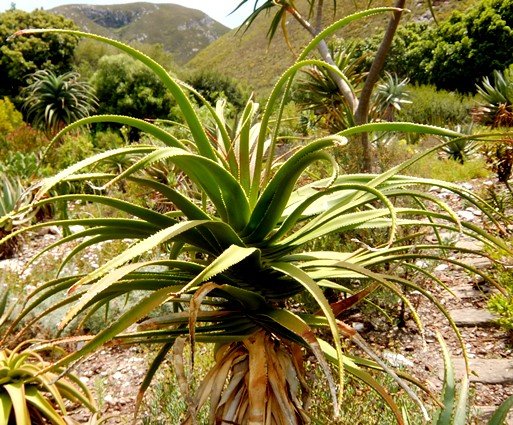Aloe pluridens leaves

Author: Ivan Lätti
Photographer: Thabo Maphisa
The leaf rosette of Aloe pluridens may be dense. If there are several of them on the plant, the main (upper) rosette may bear up to 40 pale to bright green, fleshy leaves.
The leaves are long and slender, curving down gracefully. They become about 65 cm long, only 6 cm wide (at the base) and taper gradually to their tips. The upper leaf surface is flat or slightly convex near the base, channelled towards its tip.
The leaf surfaces are spineless, while many small, triangular teeth occur along the cartilaginous margins, becoming bigger and more widely spaced towards the leaf tips. These teeth are white or pinkish in colour. The specific name, pluridens, is derived from the Latin words pluri- meaning many and dens meaning teeth, referring to the numerous teeth. The colourless leaf sap has a strong odour, reminding of rhubarb. A. arborescens, a somewhat similar plant, has yellowish sap.
Up to three inflorescences may grow from one rosette. The inflorescence may be a single raceme or branch into up to four erect racemes, the central one the longest, up to 80 cm long. Racemes are slightly conical, typically 30 cm long and 10 cm wide, bearing salmon pink to dull scarlet or orange perianths. A yellow form of the flowers is sometimes seen.
The cylindrical to slightly triangular (in cross-section) perianths are slightly indented above the ovary and widen slightly near the throat. Perianths become up to 4,5 cm long. Their inner three segments have some white and green colouring, and tips that curve out more than the inner ones; the outer three segments are free. The anthers are exserted successively in two groups of three during the life of a perianth, the stigma protruding further than the stamens.
Flowering happens from late autumn to midwinter (Frandsen, 2017; Van Wyk and Smith, 2003; Reynolds, 1974; Jeppe, 1969; iNaturalist).

